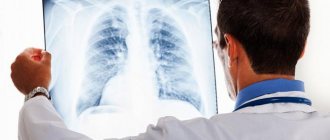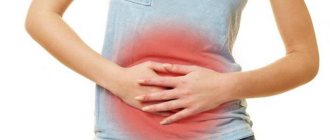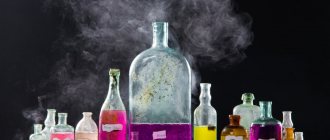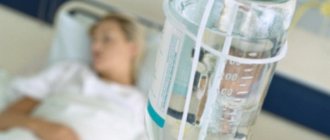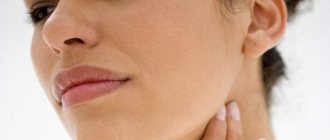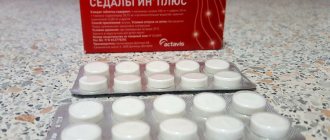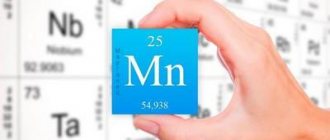Nowadays, it is difficult to find a family that does not use household hygiene products for washing, cleaning, laundry, bleaching, removing stubborn stains, disinfectants, etc. They simplify household life.
When you are in a store and see a wide range of household products in front of you, you usually don’t think about how dangerous these substances can be to your health. And when using them at home, they do not adhere to the precautions indicated on the packaging. For example, wear protective gloves, a mask or goggles when cleaning. This is explained by the fact that the components of these products are aggressive chemicals.
Causes of poisoning
Almost all household chemicals pose a danger to the human body due to toxicity. Poisoning with soap, detergents and cleaning products account for approximately a third of registered cases of intoxication (ICD-10 code X40-X49).
There are a number of causes of detergent poisoning:
- Violation of the instructions for use, use in an unventilated area.
- Violation of storage rules. Often chemicals are left in places where children, attracted by the bright label, have the opportunity to get it themselves.
- Too frequent use of products leads to the accumulation of toxins in the body.
- It is not uncommon for a person to confuse water and chemicals, drinking the latter instead of the former.
- Intoxication is caused by contact of a toxic substance on unprotected skin or through the respiratory tract.
- When toxic fumes are inhaled, irritation and ulcers appear on the mucous membranes of the mouth and nose.
What to do if you are poisoned by household chemicals?
Poisoning with household chemicals quite often results from violating the instructions for using special products used for cleaning the premises, washing dishes, washing clothes or fertilizing house plants. If adults are exposed to negative effects of chemical compounds as a result of improper handling, then children are more likely to suffer due to the natural tendency to explore everything new and unclear.
Signs and symptoms
Symptoms of poisoning may vary depending on the cause. But common signs stand out:
- Disturbances in the gastrointestinal tract.
- Attacks of nausea and vomiting.
- Headache.
- Sore throat and mouth.
- Increase in body temperature.
- Allergic rash.
- Manifestation of seizures.
- Labored breathing.
- Difficulty urinating.
The listed symptoms accompany all types of intoxication.
First aid and treatment for intoxication
If signs of poisoning appear, you must immediately invite a medical team and provide the victim with possible first aid.
What to do:
- If there is no consciousness, the victim is placed on his side. Provide him with access to fresh air.
- It is not allowed to provoke vomiting during intoxication with acids, alkalis, unknown compounds, acetone or gasoline. Such substances can cause swelling in the throat and cause respiratory arrest.
- In case of an overdose of cosmetics, the victim is given a large volume of water to drink and is induced to vomit.
- Lime that gets on the skin should not be washed off with water. The substance is removed with a napkin, the damaged area is lubricated with glycerin.
- In case of alkali poisoning, prepare a solution - take four large spoons of three percent vinegar per liter of water. Give the patient one spoon every fifteen minutes.
- In case of intoxication with acids, prepare a medicinal solution - five tablespoons of soda per liter of water. It is recommended to drink three large spoons every ten minutes.
- If household chemicals come into contact with your eyes, rinse them thoroughly with cool water. If the chemical contains chlorine, then use a two percent soda solution.
Types of poisoning
Surfactants (surfactants) are contained in washing powder and other detergents designed to combat grease stains (for example, in Pemolux). The compounds harm the skin and lipid layer. They usually accumulate in the brain, heart muscle and liver.
Main symptoms:
- Foaming at the mouth.
- Pain in the gastrointestinal tract.
- Attacks of vomiting.
- Hard breath.
- Problems with the liver.
Chloride and oxygen oxidizers
The preparations are used to combat dust and disinfect surfaces.
With regular inhalation of vapors, the following occurs:
- Swelling of the mucous membrane of the oral cavity and nasopharynx.
- Upper respiratory tract irritation. Possible suffocation.
- Tearfulness, itching and irritation of the eyes appear.
- Difficulty breathing, cough.
Due to constant continuous interaction (when working at chemical plants), diseases begin:
- Vascular atherosclerosis.
- Anemia.
- High blood pressure.
- Hair becomes brittle and dull, and begins to actively fall out.
When ingested into the body, poisons provoke:
- Hemolysis.
- Liver decomposition.
- Erosion of the mucous membrane of the mouth and trachea.
- Burn of the gastrointestinal tract.
Alkalis
They are often found in pipe cleaners and dishwashing detergents. Common types are sodium silicate, lime, soda, ammonia.
Alkali poisoning is recognized by the following signs:
- Feeling very thirsty.
- Diarrhea and vomiting with blood mixed with blood due to damage to the intestines or stomach are the most dangerous signs.
- Severe pain and swelling of the eyes and nasopharynx.
- Ulcers of the gastrointestinal tract, accompanied by severe pain.
- Suffocation.
This type of intoxication can be fatal due to painful shock, bleeding of internal organs and swelling of the lungs.
Acids
In contact with the walls of the stomach, products containing acids can burn them.
Symptoms of poisoning are the same as with alkaline intoxication.
Organophosphorus compounds
They are the main component of insect repellents. It is possible to be poisoned by chlorophos and karbofos.
Symptoms of poisoning include:
- Nervous overexcitation.
- Tearing.
- Attacks of nausea and vomiting, increased salivation.
If interaction with products containing FOS occurs over a long period of time, this provokes tremors, paralysis and cramps of the limbs, and damage to the optic nerves.
Poisoning with acids and alkalis
Acids include: nitric, hydrochloric, sulfuric acid, acetic, oxalic acid. Alkalis: caustic soda, caustic soda, caustic soda, quicklime (calcium oxide), ammonia, ammonia. In addition to acids and alkalis, iodine, acetone, bromine, phenols, sublimate, formalin, potassium permanganate also have a similar cauterizing effect. These products cause burns and severe pain. If ingested, it causes swelling of the larynx, severe vomiting mixed with blood, and intestinal bleeding. The victim's urine turns brown or red. Pulmonary edema and severe tachycardia are possible.
Signs of poisoning are: severe pain in the mouth, throat, stomach and intestines, nausea, vomiting, dizziness, general weakness (even to the point of fainting).
Start providing assistance by calling an ambulance.
acid poisoning, it is necessary to: give the victim orally every 5 minutes a tablespoon of soda solution (2 teaspoons of tea soda per glass of water) or 10 drops of ammonia diluted in water;
Give the victim milk to drink, and if breathing is impaired, perform artificial respiration; deliver the victim to the first aid station.
In case of poisoning with a strong caustic alkali, the victim must: gradually give cold water acidified with acetic or citric acid to drink (2 tablespoons of a 3% vinegar solution per glass of water); give vegetable oil inside - 2 tbsp. spoons; apply mustard plaster to the epigastric region.
· To avoid repeated burns of the mucous membranes of the mouth and esophagus by acid or alkali, give the victim two or three glasses of water, no more!
· Rinse off acid and alkali that get on the mucous membranes of the eyes or lips with a copious stream of water from the tap or from a kettle (1-2 l).
If you suspect a perforation of the esophagus or stomach (severe abdominal pain), do not give anything by mouth!
First aid for gas poisoning
Carbon monoxide, illuminating monoxide (carbon monoxide).
Poisoning is possible in production, where carbon monoxide is used for the synthesis of a number of organic substances (acetone, methyl alcohol, phenol, etc.), in garages with poor ventilation, in unventilated newly painted rooms, as well as at home when there is a leak of lighting gas and in rooms with stove heating (houses, baths).
Symptoms: loss of consciousness, convulsions, dilated pupils, severe cyanosis (blue discoloration) of the mucous membranes and facial skin.
Death usually occurs at the scene as a result of respiratory arrest and a drop in cardiac activity. Subsequently, drowsiness develops, motor paralysis is possible with preserved consciousness, then loss of consciousness and a coma with severe clonic-tonic convulsions, involuntary passage of urine and feces.
In case of gas poisoning (acetylene, carbon monoxide, gasoline vapors, etc.)
With a lower concentration of carbon monoxide, victims feel: headache, “knocking in the temples,” “ringing in the ears,” general weakness, dizziness, drowsiness; in severe cases there may be an excited state, breathing problems, and dilated pupils.
Helper actions:
Start providing assistance by calling an ambulance.
•lead or remove the victim from the gas-contaminated area;
•unfasten your clothes and provide a flow of fresh air;
•lay the victim down with his legs elevated (in case of carbon monoxide poisoning - strictly horizontally);
First aid
Before you begin to help the patient, you need to determine the source of the toxic substances. Call a doctor, during the call, consult with the duty officer on what to do.
Until help arrives, you need to take the following actions:
- Remove the chemical that the person may have inhaled and provide good ventilation.
- If the toxin gets on the oral mucosa, it must be immediately rinsed with water.
- Help the patient take a position so that if he vomits, he does not choke on the escaping masses. If the patient is unconscious, open your mouth and make sure that your tongue does not sink. If necessary, it is permissible to remove the bracket system.
- If household chemicals come into contact with the mucous membrane of the eyes, immediately rinse the cornea with plenty of running water. Substances containing chlorine are washed out with a 2% baking soda solution.
- In case of poisoning from cosmetic preparations, a person should drink as much liquid as possible to induce vomiting.
- In case of lime burns, the affected area should not be wetted. The remainder of the substance is removed with a napkin, and the burn is lubricated with glycerin.
- If the burn is caused by contact with acid, alkali or chlorine, keep the area of contact with the skin under cold water for at least 20 minutes.
- If internal alkali poisoning has occurred, the following methods will help alleviate the condition. For the first you need a weak solution of vinegar: 1 liter. water is added 4 tbsp. spoons of vinegar (3% concentration). The solution is given to the patient 1 tbsp. spoon every 15 minutes. In the second case, to alleviate the condition, the victim is given 1 tbsp. spoon of vegetable oil every half hour.
- If acid has entered the body in an unknown way, the patient’s condition can be alleviated with the help of a soda solution (5 tablespoons of soda per 1 liter of water). Take 3 tbsp solution. spoons every 10 minutes. Milk (one sip every 10-15 minutes) and raw egg white are beneficial.
How does household chemical poisoning occur?
Household chemicals are available in every home, and therefore poisoning with these substances is one of the most common. Intoxication of the body can occur in the following cases:
- non-compliance with safety measures regarding the use of purchased funds, lack of protective equipment;
- improper storage in inappropriate or damaged containers, in places accessible to children;
- contact of the substance with the skin and mucous membranes;
- inhalation of toxic fumes, especially when working in a poorly ventilated area;
- ingestion of detergents and other toxic substances;
- regular use of household chemicals, which leads to the accumulation of harmful compounds in the human body.
Important: very often small children suffer from household chemicals, as they can spill or swallow some dangerous product on themselves if the requirements for its storage are not followed.
What drugs can cause intoxication?
There are many household chemicals that can cause serious intoxication. The main sources of potential danger include:
- solvents;
- cleaning products based on chlorinated hydrocarbons;
- organophosphate insecticides;
- repellents;
- foaming detergents and powders;
- strong acid-based household chemicals;
- alkaline detergents;
- alcohol cosmetics;
- foaming cosmetics.
What not to do
Potassium permanganate, activated charcoal, enemas, and inducing vomiting are the most popular methods used in cases of poisoning. But in case of chemical intoxication, such first aid will only cause additional harm.
- Potassium permanganate is a strong oxidizing agent. If the powder is not completely dissolved and a manganese crystal enters the gastrointestinal tract, the mucous membrane is injured even more.
- Activated charcoal is recognized as an excellent remedy for mild digestive problems. But when the body interacts with a caustic or foaming liquid, the dosage of the drug increases from a tablet per 10 kg of the patient’s weight to a tablet per 1 kg of live weight. With a burned larynx, taking such a number of tablets will be torture.
- In many situations, the patient should not consume anything at least until doctors arrive.
- Vomiting can cause additional damage to the mucous membranes and respiratory tract when consuming scalding liquids. And if foaming gels get into the stomach (shampoo intoxication), the foam that comes out along with the vomit can cause suffocation.
- An enema will not benefit the affected body. When used, the caustic substance will pass into the small intestine, and from there into the circulatory system, injuring the lining of the intestinal walls. Doctors use special equipment to lavage the stomach.
It is important to remember that in case of poisoning with a foaming substance or possible perforation (this will become clear from the appearance of stomach pain), the victim should not drink!
Poisoning with organophosphorus compounds (OP)
FOS include: karbofos, dichlorvos, chlorophos.
First aid:
Start providing assistance by calling an ambulance.
· Take the victim to fresh air;
· remove soaked clothing; if the product gets on the skin, wash with soap and water;
· vomiting can be induced only when the patient is conscious: 1-2 glasses of saline solution (1 teaspoon of salt per glass of water).
IN POISONING FROM COSMETICS, STAIN REMOVERS, ANILINE DYES
Start providing assistance by calling an ambulance.
· before the ambulance arrives, INDUCE THE VICTIM TO VOMIT if he is conscious. To do this, drink 2-3 glasses of salt water and press the root of the tongue with two fingers wrapped in a clean cloth.
· If the victim is unconscious, lay him down so that his head is turned to one side. This will prevent stomach contents from entering the respiratory tract.
· If the tongue sinks, as well as convulsions, when the jaws are tightly closed and prevent normal breathing, carefully tilt the victim’s head back, push the lower jaw forward and up so that he can breathe through the nose.
Treatment
Further therapy should be carried out exclusively in hospitalization. The main methods of treating poisoning are:
- Gastric lavage with a probe.
- The use of intravenous injections with medicinal solutions.
- Blood transfusion.
- Prescription of medications that restore the normal functioning of internal organs and systems.
- If necessary, the patient is transferred to intensive care.
Eliminating the consequences of such intoxication is quite difficult. But it's doable. It is important to provide first aid in a timely manner and hospitalize the victim, especially if a child is injured. The time required for recovery directly depends on the strength and degree of poisoning.
Consequences
Even if first aid and treatment for poisoning with household chemicals were carried out promptly and competently, consequences may remain.
Contact dermatitis that occurs due to constant or prolonged use of chemicals without skin protection is considered not too severe. These diseases easily become chronic, when ulcers and long-lasting wounds and cracks appear on the skin.
Another consequence of inhaling toxic chemical vapors is irritation of the mucous membranes of the larynx and nose.
Severe complications include:
- destruction of red blood cells, leading to cessation of blood supply to the brain (sometimes fraught with cardiac arrest);
- scars on the walls of the digestive organs from burns;
- damage to the respiratory system;
- impaired renal function (urine with blood);
- paralysis of the smooth muscles of internal organs due to malfunctions in the digestive system;
- removal of internal organs irreparably damaged by burns.
But the worst consequence of poisoning with household chemicals is death, and this can happen much faster in children than in adults.
Have you ever been poisoned by detergents or cleaning products?
Complications and prevention
Intoxication with household chemicals harms the entire body:
- Inflammation of the mucous membrane and burn of the gastrointestinal tract and esophagus.
- Infection of the circulatory system, as a result, disruption of the functioning of the cardiovascular system and brain.
- Malfunction of the kidneys and liver.
- Paralysis of the muscle fibers of internal organs.
- In case of severe poisoning, coma and death are possible.
To prevent this from happening, you need to follow a number of simple precautions:
- Read the instructions carefully and follow them strictly.
- Get to work, always using personal protective equipment.
- After use, the packaging of cleaning products should be tightly closed to avoid the risk of inhaling fumes.
- Storage of chemicals is permissible only in places inaccessible to children.
- Storing household chemicals near food products is strictly prohibited.
- You should not drink liquid from a bottle with a missing label; there could be anything inside.
How can you get poisoned?
Getting poisoned by detergents is not that difficult. All of them are used in different everyday areas; people come into contact with them every day, which means there is always a risk of intoxication.
You can be poisoned by these drugs for several reasons:
- inhaling vapors indoors;
- when aggressive liquids come into contact with the skin;
- after accidental or intentional ingestion (in the first case, if the drug ended up in the hands of a child, in the second, for the purpose of suicide or harm to one’s own health).
All these reasons are a consequence of careless handling of chemicals. It is no less dangerous to use any household product for other purposes or to mix different drugs, supposedly to achieve a greater effect.
What are the types of poisoning in everyday life?
There are several types of poisonings that can occur at home. Toxic substances enter the body in various ways and affect either the respiratory system or the digestive tract.
Food intoxication
Low-quality products that have expired contain toxins and microbes that cause symptoms of poisoning. In addition, improper storage and non-compliance with cooking conditions can also cause serious harm to health.
There are two types of food intoxication:
- Non-infectious. Develops when poisonous mushrooms or chemicals enter the body (for example, if you eat vegetables or fruits after being treated with chemicals).
- Infectious. This disease is associated with pathogenic microorganisms that are often present in stale and unwashed food.
Many people experience food poisoning, but everyone knows how intoxication manifests itself. Based on information about the symptoms, you can begin providing first aid in a timely manner.
- diarrhea and bowel dysfunction;
- chills and weakness;
- acute pain in the stomach;
- fever;
- nausea.
The first signs appear 2-3 hours after eating low-quality food. In rare cases, the illness may appear the next day. In children, symptoms occur quickly, after 1-2 hours.
What should first aid be?
- As soon as you realize that food poisoning has occurred, you need to give the victim 2-3 liters of warm water to drink. You should drink in small sips. Liquid in large volume should cause vomiting. This will be a kind of gastric lavage. It’s just important to act immediately, before the poisons are absorbed into the blood.
- If vomiting does not occur, then you should wash your hands and press on the root of the tongue. It is better to place the victim in a lying position on his left side. This way he won't be able to choke on vomit.
- Next you need to give a sorbent. The drug will help absorb remaining harmful substances and remove them through the digestive tract naturally. Sorbents are produced in solid and liquid form, so if a child has been poisoned, it will not be difficult to choose the right product for the child’s age. You can use Smecta, activated carbon, Atoxil, Regidron, Enterosgel.
- Follow the diet for a few days. After an unpleasant incident, the body will not take food for some time, and there will be no appetite either. Therefore, you need to unload the digestive tract for 2-4 days. The menu should include porridge with water, jelly, homemade crackers, low-fat soups and broths.
In the future, to prevent this from happening, you should only eat dishes that contain only fresh ingredients, and follow all the rules during cooking.
Before sitting down to eat, it is important to wash your hands with soap. Fresh food should taste and smell good. If there is even the slightest suspicion that the product is not fresh, it is better to throw it away.
Alcohol
Low-quality alcoholic drinks, if consumed in large quantities, damage the kidneys, liver, and cardiovascular system. Low-quality alcoholic beverages are poison for the body.
The following symptoms appear:
- severe dizziness;
- nausea;
- difficulty breathing;
- frequent vomiting;
- drowsiness and weakness;
- loss of appetite.
Severe vomiting, which is an integral sign of alcohol poisoning, often leads to the fact that a person may choke, especially if this happens during sleep.
How to provide first aid to a victim:
- The first thing to do is induce vomiting. You can give a lot of warm water to drink, or you can immediately press two fingers on the root of the tongue.
- After cleansing the stomach of toxins, it is important to take a sorbent drug (Smecta, Regidron, activated carbon).
- A contrast shower will help normalize the functioning of blood vessels and restore blood flow. The main thing is not to take a cold shower, because in this case the blood vessels narrow greatly, and after alcohol poisoning they are already narrowed.
- You can try one of the traditional methods to alleviate the condition. For example, a decoction of lemon balm will help save you from severe nausea. To do this, pour 1 tsp into a glass of boiling water. herbs. Let it brew until the broth reaches room temperature. Drink in small sips. Repeat the procedure 3-4 times a day.
- Diet is equally important while providing care. The victim should be offered protein foods. This could be an omelet of 2-3 eggs, hard cheese, kefir, meat broth.
You need to understand that unknown brands of alcoholic beverages may have questionable composition, which is fraught with irreparable consequences for health. The greatest danger comes from breathing problems. Paralysis of the respiratory system often ends in death.
Chemistry
We are talking about medicines and household chemicals. Bright and colorful bottles that contain household cleaning products often attract young children who want to see and taste everything.
Adults are also often exposed to chemical poisoning, for example, vapors or contact of toxic substances on the skin, or drug overdose.
Chlorine-containing disinfectants, paints and products used to kill harmful insects are considered especially dangerous. Despite the fact that there are quite a lot of signs, we need to briefly discuss the most common ones.
